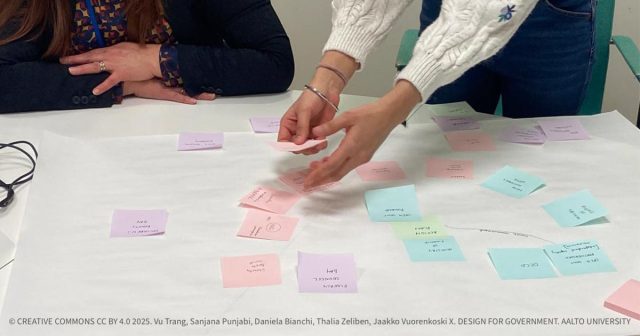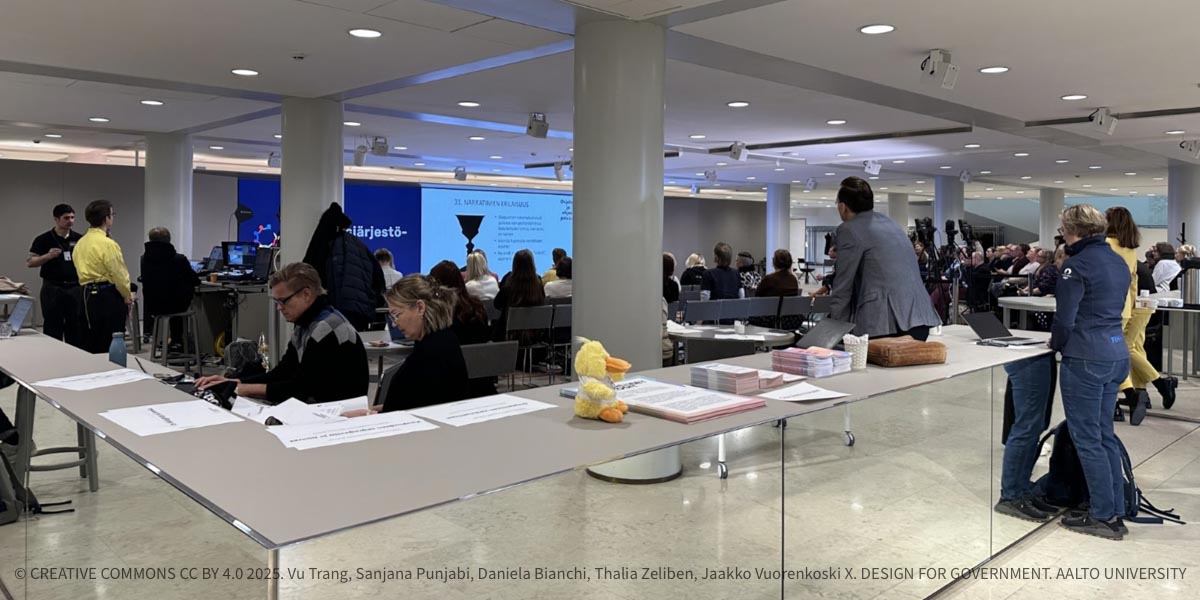This blog post reports on work-in-progress within the DfG course! The post is written by group 1 dealing with the Ministry of Finance’s brief on ‘Open Governance’. The group includes Vu Trang from the Sustainable Entrepreneurship program (Aalto BIZ), Sanjana Punjabi from the Collaborative and Industrial Design program (Aalto ARTS), Daniela Bianchi from Collaborative and Industrial Design program (Aalto ARTS), Thalia Zelißen from the Environmental Engineering Program (TU Munich) and Jaakko Vuorenkoski from Information and Service Management program (Aalto BIZ).
Written by: Vu Trang
Previously, for the course’s mid-term review, our group mapped out the working structure of Open Government, specifically focusing on its relationship with stakeholders. This attempt inspired us to reframe our original project brief to ‘How can redefining the roles of all stakeholders transform Open Government into an orchestrator of action coherence?’.
In between the mid-term review and this blog post, we conducted interviews with Open Government Finland, spokespeople for Open Government from the municipalities of Oulu and Helsinki, in addition to experts and representatives from civil societies. The fieldwork had us question our reframing of Open Government as an orchestrator as well as the original project brief of an ‘age-friendly’ Finland.
Open Government: a working concept
To get a better understanding of Open Government’s operational model, we prepared a small workshop for one of the Open Government specialists – Ira Alanko – during our interview with her. We ultimately wanted to compare the differences in our perception of Open Government and that of the internal team and clarifying any tacit assumption.

Figure 1. Reorganizing stakeholders
First, we drafted a digital visualization of the linkages between Open Government and partners according to the information presented on Open Government’s website. We envisioned a relatively top-down model with separate connections, where a partner of one particular activity had nothing to do with those behind other activities. After showing this same visualization to Ira, we made a paper version with an A1 sheet and post-it notes to prompt her to rearrange the placement of the activities and partners.
To our amusement, the post-it notes representing the partners together started to orbit orbit around the Action Plan. The same was done to the notes representing the activities, which formed an outer orbit. The Action Plan in this case turned out to be the core of all Open Government work. Partners, regardless of their scope (international, national, or local), all work together, either directly or through Open Government. While we previously imagined Open Government as an orchestrator coordinating different partners’ efforts, it now appears to be more of a working concept thriving on a peer-to-peer network.

Figure 2. Revised Visualization: Sphere of Collaboration
Adding depth to this revised working model, a civil society actor we interviewed also commented that Open Government was ‘a way of doing things’. Another interviewee also explained that they had more or less work with similar principles even before collaborating with Open Government. Following these interviewees’ words, we revisited the Open Government’s nine principles and realized that a number of these can be found in the constitution. The fact that certain principles promoted by Open Government are deeply rooted values in Finnish society may partly explain the fruitful collaboration made between Open Government and various partners.
(In)visible movement
In light of this new discovery, we could not help but wondering how much visibility Open Government should have. This question stems from a fascinating observation of ours while reaching out to potential interviewees. While Open Government is known and even highly praised by some contacts, the name does not ring the bell at all for others despite our anticipation.
On the one hand, we understand that having a strong presence such as a logo or big posters at events could make Open Government appear too formal or institutional to individuals foreign to the concept. We acknowledge Open Government’s strategy of creating an approachable image and setting a low threshold channel for collaboration for potential partners. Too much visibility, indeed, could get in the way of Open Government becoming a working concept responsible by the whole public administration and not just the Ministry of Finance. In fact, Open Government has been promoting and sharing good practices by a wide range of actors both inside and outside its circle.
On the other hand, we could also see a big benefit coming with a more well-known image among civil servants and civil societies, if not also citizens. In Finland, there are almost 109 thousand associations and religious communities (PRH, 2025), which is a high number compared to the population. Although Open Government has secured successful partnerships with some associations, there is still a lot of untapped potential for those distant to Open Government, whether geographically or because of a lack of mutual connection.
Age is just a way of looking at it
Parallel to testing our reframing, we also managed to gather valuable insights regarding the project’s brief – an age-friendly Finland. While opinions vary, there is, however, an overall consensus among interviewees that grouping people into brackets such as ‘65+’ could produce counterproductive outcomes. This is because, as one interviewee pointed out, there is a great diversity in the age group from 65 to 105. The person then compared a newborn baby and a 40-year-old adult for a bit more illustration. Notably, another interviewee said that age-friendly already sounded not friendly and the categorization into groups could leave people behind as nobody could not be put in one box.
An alternative way of segmentation for analysis could be need or issue-based basis. Loneliness, for example, was named in several interviews as a problem not unique to only one age group. According to Statistics Finland (2023), out of seven listed age groups, roughly the same percentages of people aged 25-34 and 75-84 having experienced loneliness. Interestingly, the 35-49 group, being much closer in age to the 25-34 than 75-84, had a considerably lower figure compared to their younger peers. Why so? We look for more studies on the matter and find additional parameters such as socio-economic backgrounds or whether the person lives alone to be alternative segmentation factors.
Coming back to the term ‘age-friendly’, we acknowledge the tension between being broad and staying specific when it comes to group representation. It is tricky because people need to feel seen and heard with the issues they face that, admittedly, other society members also encounter. In that sense, statistics, with age as a usual tool for segmentation, have a story to tell. At the same time, there are instances where people experience a sense of misrepresentation when being assigned into age brackets of vast width (say, being grouped into the 65+ for an 85-year-old person). Whether the term ‘age-friendly’ could convey this delicate balance between broadness and specificity is still a question mark for us.
Ramping up for the final show
For the upcoming days, our two most important questions would be:
- If Open Government is a working concept, how do we better communicate its sprit to and engage more relevant actors and even citizens?
- How does the term ‘age-friendly’ resonate with relevant stakeholders, especially under the principles of Open Government?
With these guiding questions and fieldwork’s insights in mind, we are excited to welcome our partner – Open Government Finland, in an upcoming co-creation session. This ideation opportunity, along with all the gathered information, would serve as the basis for our narrative for change – a better version of present and how to get there (Steinberg, 2025) and entry (or leverage) points – actions, places, or people that could trigger a change (Meadows, 1999).
Until the final show, please stay tuned!
References
Meadows, D. H. (1999). Leverage points: Places to intervene in a system. https://donellameadows.org/archives/leverage-points-places-to-intervene-in-a-system/
PRH Finnish Patent and Registration Office. (2025, January 03). Number of associations and religious communities. https://www.prh.fi/en/yhdistysrekisteri/statistics/numberofassociationsandreligiouscommunities.html
Statistics Finland. (2023, March 31). Altogether 29.7 per cent of persons aged 16 or over experienced loneliness in 2022. https://stat.fi/en/publication/cl8sh640so9n30bw7s21tu6s8
Steinberg, M. (2025) Slide from ‘’Introduction to Vision building’’ presentation. https://mycourses.aalto.fi/pluginfile.php/2264330/course/section/267562/Introduction%20to%20vision%20building.pdf
The DfG course runs for 14 weeks each spring – the 2025 course has now started and runs from 24th Feb to 27th May. It’s an advanced studio course in which students work in multidisciplinary teams to address project briefs commissioned by governmental ministries in Finland. The course proceeds through the spring as a series of teaching modules in which various research and design methods are applied to address the project briefs. Blog posts are written by student groups, in which they share news, experiences and insights from within the course activities and their project development. More information here about the DfG 2025 project briefs. Hold the date for the public finale on Tuesday 27th May!

